INDEX
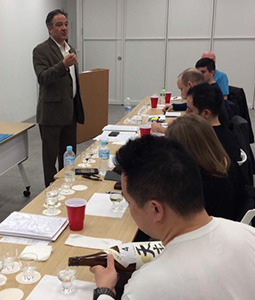
Gauntner gives a lecture 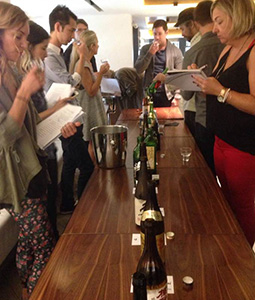
Participants on a Sake Professional Course held in Toronto, Canada, 2016 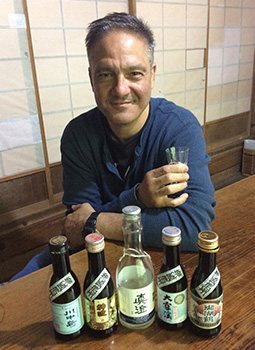
Gauntner on a sake-tasting visit to Nagano Prefecture
November 2020
The Sake Evangelist
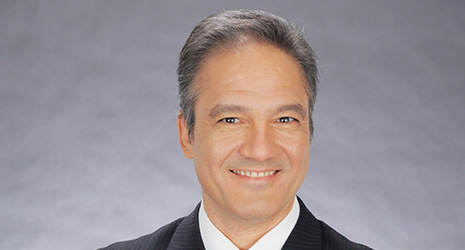
US-born former-engineer John Gauntner was captivated by Japanese sake and became a sake journalist. Since then he has communicated the delights of sake to people all over the world through a range of activities, including writing, lectures and running sake courses.
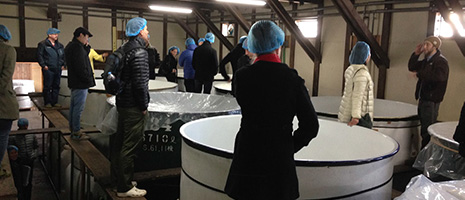
According to figures announced in February 2020 by the Japan Sake and Shochu Makers Association, which represents around 1,730 breweries and distilleries across Japan, exports of sake in 2019 had gone up for the tenth year in a row and were worth a record high 23.4 billion yen, more than three times the figure in 2009. The top market for exports was the United States and the second, China.
“These last ten years, there’s been a huge increase in the number of Americans who drink sake,” says John Gauntner. “I think this is not only because Japanese food has become more popular, but also because wine sommeliers are getting interested in sake and starting to recommend it to diners at their restaurants.”
Ohio-born Gauntner’s work includes writing articles on sake, giving presentations and exporting sake. He is known as a “sake evangelist.”

Although he worked as an engineer at an electrical manufacturer after graduating from a local university, he decided that he “wanted to have an adventure before getting old.” He successfully applied for the JET Programme, which invites young people to Japan from overseas to engage in international exchange and foreign language teaching, and came to Japan in 1988 as an “assistant language teacher” of English.
It was New Year 1989 when he discovered sake’s fascinations, a few months after he’d started teaching at some high schools in Kanagawa Prefecture. A sake-aficionado coworker invited Gauntner to his home to taste and compare sake from breweries in Tohoku, Shikoku, Kyushu and elsewhere.
“Although I’d had sake before, I thought they all tasted the same,” he remembers. “But the sakes I drank that day each tasted totally different. What’s more, the flavors were extremely rich and complex. From then on my life changed.”

Gauntner stayed on in Japan after finishing the JET Programme and, while working as an engineer in Tokyo, deepened his knowledge of sake by drinking sake at izakaya, visiting breweries and reading books on the drink. Meanwhile, by chance he met a journalist at the Japan Times who suggested he write a column on sake for the newspaper. That led to a variety of sake-related work arriving, including giving lectures and writing for publications on sake.
In 1998, he quit his job as an engineer and decided to focus squarely on his sake work. That’s how broad and deep the fascination of sake was for Gauntner.
Varying elements can produce a truly diverse range of flavors in sake, including the base ingredients of rice and water, how the sake is made, and the climate and cuisines of the producing area. Even the same sake will taste differently depending on whether it is drunk at room temperature or chilled. Gauntner was also astonished by the tremendous skill of the brewmasters who make sake. For example, in sake production there is a process prior to steaming the rice where it is soaked in water. The brewmasters make an extremely precise judgment—without any measuring equipment—as to how long to soak the rice and how much water the rice will absorb.

“All the processes of sake production rely on highly-experienced brewmasters. Of course, they also use modern science and technology, but at the end of the day it is their experience and intuition that is most important,” explains Gauntner.
Having amassed sake knowledge and experience, in 2010 Gauntner became the first non-Japanese person to be certified as a Master of Sake Tasting. In 2015, he became the first non-Japanese person to serve as a judge in the finals of the Annual Japan Sake Awards. Through these and other activities, Gauntner has established his position as a sake specialist.
One particular activity that Gauntner has put much effort into is his Sake Professional Course, launched in 2003. Gauntner teaches this intensive 3–5 day course himself, covering the history and culture of sake, different kinds of sake, the brewing process, and other topics. The course is held not just in Japan, but also the United States, Canada, China and Singapore. To date, more than 2,000 people have taken part. In principle, classes are conducted in English, so many participants are non-Japanese, including on the courses held in Japan. During the course, students not only taste a range of sakes but, in Japan, also visit breweries and study the sake production process. Due to COVID-19, at present Gauntner is running the Sake Professional Course online. But he says that since students can participate from anywhere in the world, the range of nationalities has become more diverse.
“Once COVID-19 is over, I’d like to quickly restart our brewery visits. I just love talking with people of the breweries,” says Gauntner. “Sake breweries are the equivalent to chateaux in the wine world, but people outside Japan still don’t get much information about those sake breweries. To make sake more popular overseas, we need to communicate even more information about the people who make sake.”

